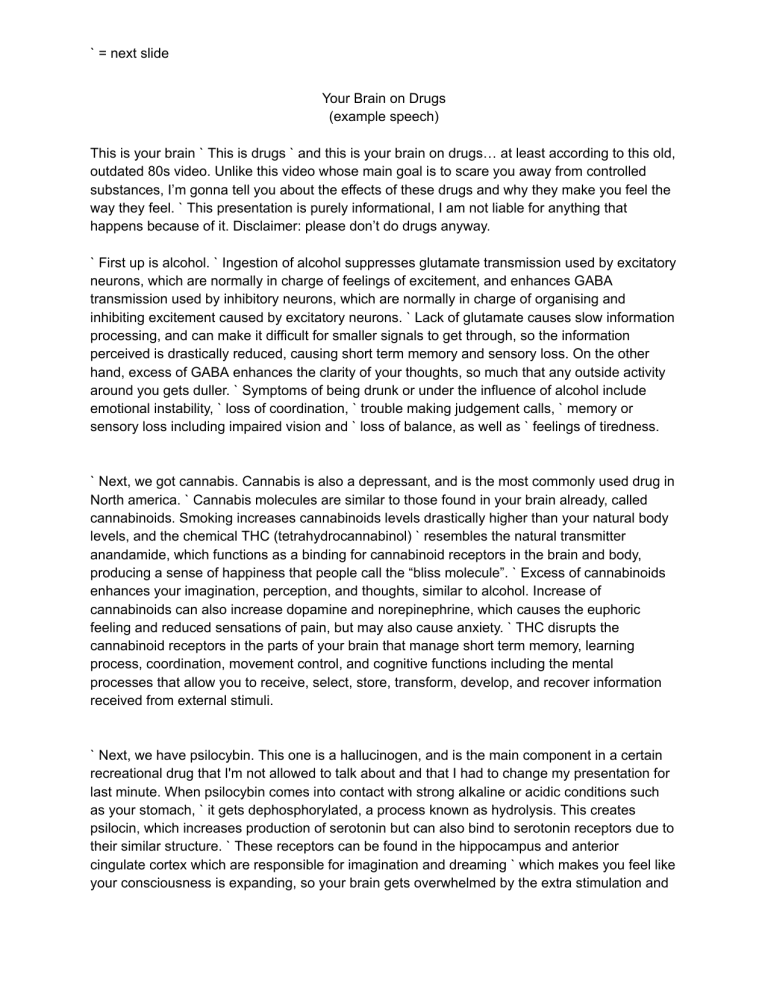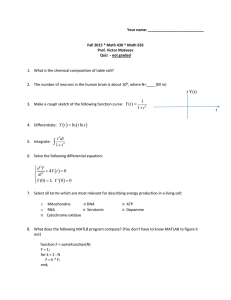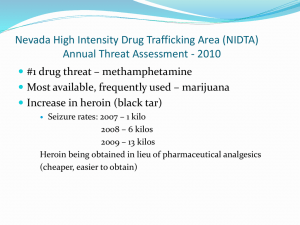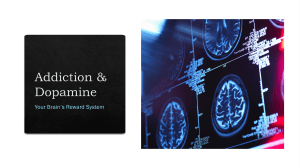
` = next slide Your Brain on Drugs (example speech) This is your brain ` This is drugs ` and this is your brain on drugs… at least according to this old, outdated 80s video. Unlike this video whose main goal is to scare you away from controlled substances, I’m gonna tell you about the effects of these drugs and why they make you feel the way they feel. ` This presentation is purely informational, I am not liable for anything that happens because of it. Disclaimer: please don’t do drugs anyway. ` First up is alcohol. ` Ingestion of alcohol suppresses glutamate transmission used by excitatory neurons, which are normally in charge of feelings of excitement, and enhances GABA transmission used by inhibitory neurons, which are normally in charge of organising and inhibiting excitement caused by excitatory neurons. ` Lack of glutamate causes slow information processing, and can make it difficult for smaller signals to get through, so the information perceived is drastically reduced, causing short term memory and sensory loss. On the other hand, excess of GABA enhances the clarity of your thoughts, so much that any outside activity around you gets duller. ` Symptoms of being drunk or under the influence of alcohol include emotional instability, ` loss of coordination, ` trouble making judgement calls, ` memory or sensory loss including impaired vision and ` loss of balance, as well as ` feelings of tiredness. ` Next, we got cannabis. Cannabis is also a depressant, and is the most commonly used drug in North america. ` Cannabis molecules are similar to those found in your brain already, called cannabinoids. Smoking increases cannabinoids levels drastically higher than your natural body levels, and the chemical THC (tetrahydrocannabinol) ` resembles the natural transmitter anandamide, which functions as a binding for cannabinoid receptors in the brain and body, producing a sense of happiness that people call the “bliss molecule”. ` Excess of cannabinoids enhances your imagination, perception, and thoughts, similar to alcohol. Increase of cannabinoids can also increase dopamine and norepinephrine, which causes the euphoric feeling and reduced sensations of pain, but may also cause anxiety. ` THC disrupts the cannabinoid receptors in the parts of your brain that manage short term memory, learning process, coordination, movement control, and cognitive functions including the mental processes that allow you to receive, select, store, transform, develop, and recover information received from external stimuli. ` Next, we have psilocybin. This one is a hallucinogen, and is the main component in a certain recreational drug that I'm not allowed to talk about and that I had to change my presentation for last minute. When psilocybin comes into contact with strong alkaline or acidic conditions such as your stomach, ` it gets dephosphorylated, a process known as hydrolysis. This creates psilocin, which increases production of serotonin but can also bind to serotonin receptors due to their similar structure. ` These receptors can be found in the hippocampus and anterior cingulate cortex which are responsible for imagination and dreaming ` which makes you feel like your consciousness is expanding, so your brain gets overwhelmed by the extra stimulation and ` = next slide makes you perceive things that aren’t actually there, known as hallucinations. These can be visual, auditory, kinesthetic, etc. and usually hallucinations last for 3-8 hours at a time but can feel longer or shorter since the drug disrupts your perception of time. ` Next, we have Adderall or Cynthia's favourite. This one is a stimulant, and its full name is Amphetamine Salts. As you can probably tell by the name, it is a close relative to another certain recreational drug that I am not allowed to talk about. However, while this drug was originally developed to treat ADHD, now people commonly use it as a study enhancer. Adderall targets the neuroreceptors in your central nervous system and increases production of serotonin and dopamine which are responsible for making you feel happy. Since ADHD was found caused by dysfunctional dopamine release making the brain want to seek external stimulants to make up for the lack of dopamine, taking adderall can increase dopamine levels and turn overstimulation into a normal amount of stimulation, hence why it is said to treat ADHD. However, while Adderall also increases norepinephrine which increases alertness, it does not work for non ADHD havers, as studies have shown that the only increase in productivity or cognitive functions were due to the placebo effect. Long term usage of adderall leads to the brain being unable to naturally produce dopamine or serotonin, so you need to take more to get the same effect which leads to addiction. Patients of adderall abuse have reported being unable to feel happiness or pleasure without a chemical stimulant. ` Last but least, we have Caffeine. When you stay up late like I did when I wrote this shadspeak, mitochondria continue to produce atp, and since the brain uses atp when awake, it causes adenosine to accumulate. Adenosine is a hormone that makes you feel drowsy, so you feel extremely exhausted after pulling an all-nighter. Caffeine blocks adenosine receptors in the brain, so you feel awake for the time being but also causes adenosine buildup at an even higher rate, leading to eventual extreme exhaustion once it wears off. So don’t drink too much caffeine, ` even if you have 80 pages of a design project to do. ` Thanks for listening and please don’t do drugs!!!!!



